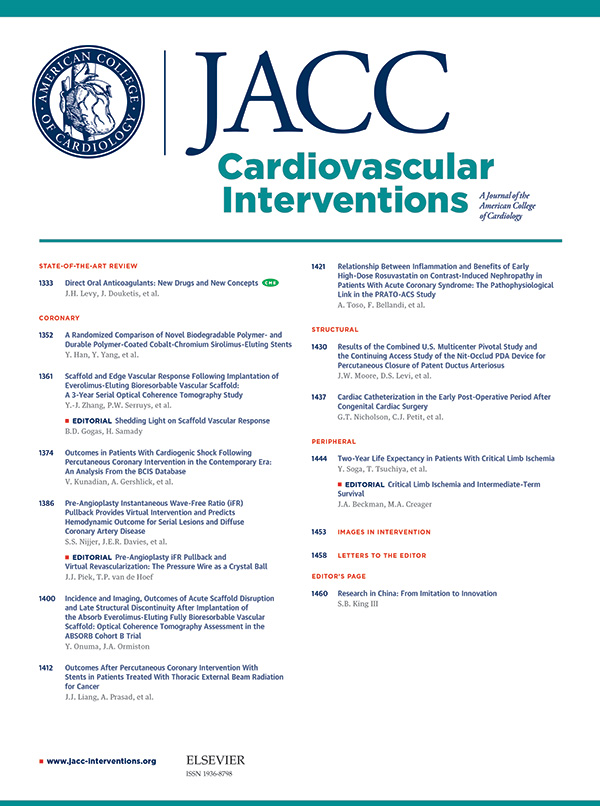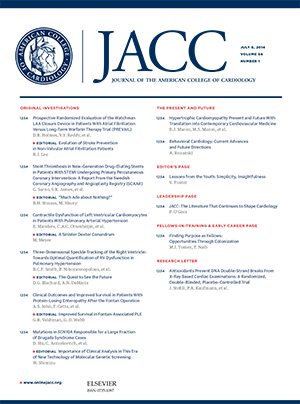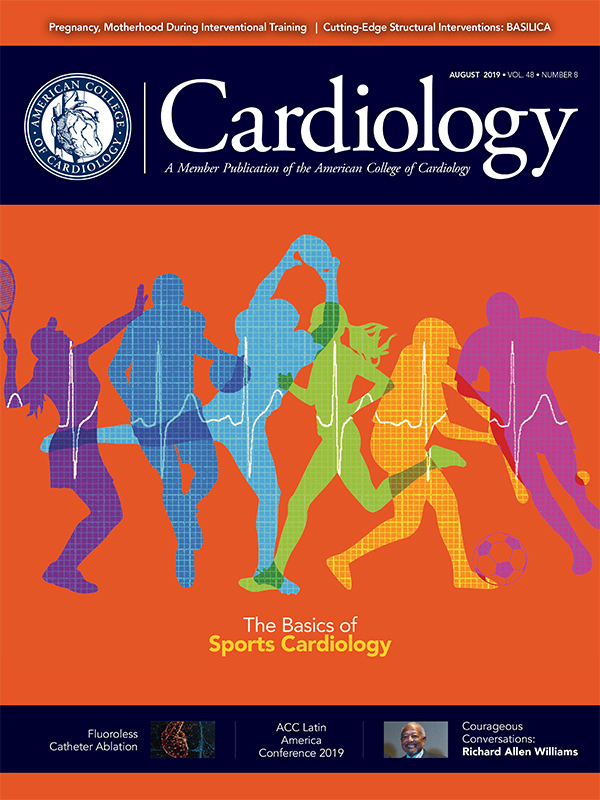JACC in a Flash
Featured topics and Editors' Picks from all of ACC's JACC Journals.
Machine Learning Has Predictive Value For PCI Outcomes

Machine learning is more predictive and discriminative than standard regression methods at identifying PCI patients at risk for 180-day cardiovascular mortality and 30-day congestive heart failure (CHF) rehospitalization, but not in-hospital mortality, according to a study published in JACC: Cardiovascular Interventions. Machine learning may also be effective at identifying subgroups at high risk for post-procedure mortality and readmission.
Chad J. Zack, MD, MS, et al., studied 11,709 patients who underwent 14,349 PCIs between January 2004 and December 2013. Demographic and clinical parameters known at the time of admission were used to predict in-hospital mortality and additional variables available at discharge were examined to identify patients at risk for CHF readmission.
For each event, the researchers trained a random forest regression model to estimate the time-to-event. They then used the predicted time-to-event as a score, generated a receiver operating characteristic curve, and calculated the area under the curve (AUC). Model performance was then compared with a logistic regression model using pairwise comparisons of AUCs and calculation of net reclassification indices.
The predictive algorithm identified a high-risk cohort representing 2 percent of all patients who had an in-hospital mortality of 45.5 percent compared with a risk of 2.1 percent for the general population. Advancing age, CHF and shock on presentation were the most predictive.
Of the patients who survived to discharge, 339 (3 percent) died from any cause within 180 days of leaving the hospital. The machine learning model identified a small subgroup of patients (1 percent) at substantially higher risk for cardiovascular death (13 percent) at 180 days. The model had good discriminatory ability for 180-day cardiovascular mortality that was significantly better than the discriminatory ability of the reference logistic regression, leading to a net reclassification improvement of 0.02 percent.
The risk of 30-day CHF readmission for patients surviving until discharge was 0.7 percent. A high-risk group comprised of 1 percent of all patients was identified with a risk of 30-day CHF rehospitalization of 8.1 percent using machine learning. The readmission model had excellent discriminatory ability and significantly outperformed the reference logistic regression model.
"Our models incorporated all available variables, many of which are unlikely to be included in traditional logistic regression models," the authors write. "In addition, the models were able to identify patient subgroups who were at increased risk for procedure-related complications. Preemptively identified high-risk patients can be potentially treated with interventions to reduce mortality and rehospitalization both in-hospital and after hospital discharge."
They conclude that the study supports "the potential role for the integration of machine learning into clinical practice for the identification of high-risk populations following PCI."
Zack CJ, Senecal C, Kinar Y, et al. JACC Cardiovasc Interv 2019;Jun 26:[Epub ahead of print].
NCDR: Outcomes Improved With More Institutional TMVr Experience

Increased institutional experience with transcatheter mitral valve repair (TMVr) with MitraClip is associated with improved procedural success, shorter procedure times and fewer complications, according to a study published in JACC: Cardiovascular Interventions.
Adnan K. Chhatriwalla, MD, FACC, et al., used the STS/ACC TVT Registry to examine the association between institutional experience and outcomes in 12,334 patients who underwent TMVr with MitraClip at 275 sites.
The researchers looked at hospital volumes and their effect on procedural success, procedure time and procedural complications by stratifying procedures into three tertiles based on institutional case sequence and examining baseline demographics, procedural data and complications across all tertiles. The study's primary outcome was in-hospital procedural success.
According to the results, "optimal" procedural success – defined as ≤1+ residual mitral regurgitation (MR) without mortality or need for cardiac surgery – increased across tertiles of case experience, with 62.0 percent in the lowest-performing tertile, 65.5 percent in the middle tertile and 72.5 percent in the highest-performing tertile.
Procedural time and complications decreased based on institutional case experience. In addition, "acceptable" procedural success – defined as ≤2+ residual MR without mortality or need for cardiac surgery – increased based on institutional experience, with rates of 91.2 percent, 91.2 percent and 92.9 percent for the lowest-performing, middle- and highest-performing tertiles, respectively.
The researchers noted improvements in procedural success, procedure time and procedural complications after an institution performed about 50 cases, with continued improvement up to 200 cases.
In an accompanying editorial, Gregg W. Stone, MD, FACC, writes the study "provides novel insights into the relationship between institutional MitraClip volume and in-hospital outcomes."
Additional research is needed to "guide subspecialty and societal decision-making regarding the optimal number of mitral centers of excellence and operators, and the minimal number of procedures required to achieve and maintain an acceptable level of competence, let alone excellence."
Chhatriwalla AK, Vemulapalli S, Holmes DR Jr., et al. JACC Cardiovasc Interv 2019;12:1342-52.
Lower Education Level Associated With CVD, Mostly Due to Smoking

Lower education level is associated with increased subclinical atherosclerosis, mostly due to a higher level of smoking in this population, according to a study published in the Journal of the American College of Cardiology.
Lidia Redondo-Bravo, MD, MPH, et al., analyzed SES (socioeconomic status), lifestyle habits (smoking, dietary patterns, physical activity and hours of sleep), traditional risk factors and extent of subclinical atherosclerosis in 4,025 individuals without known cardiovascular disease aged 40 to 54 years in the PESA study.
PESA is a prospective cohort study of asymptomatic individuals working at Santander Bank Headquarters in Madrid, Spain. After factors associated with atherosclerosis were identified, a multiple mediation model was created to quantify the effect of SES on subclinical atherosclerosis as explained by lifestyle behaviors.
There was no association between income level and atherosclerosis, but there was an association seen with education level. Participants with no university education presented at higher risk of generalized atherosclerosis.
Among lifestyle factors demonstrating an association with education level, smoking status, cigarettes per day, years since stopping smoking (former smokers) and dietary pattern were also associated with the presence of generalized atherosclerosis. Diet became nonsignificant after adjusting for age and sex.
"SES in general, and education level in particular, are associated with a greater prevalence of diffuse atherosclerosis in young individuals at a low-to-moderate cardiovascular risk," the authors write. "This effect seems to be mostly mediated by the greater prevalence of smoking and the higher number of cigarettes smoked, whereas we could not find a significant effect of more unhealthy dietary patterns or other habits or risk factors," wrote the authors.
They conclude that smoking cessation programs are still needed, particularly in populations with lower education level.
The authors acknowledge that a limitation of this study is the relative homogeneity of the population, who all worked in the same office, influencing the range of education and economic levels as well as dietary patterns.
Redondo-Bravo L, Fernández-Alvira JM, Górriz J, et al. J Am Coll Cardiol 2019;74:526-35.
Review Paper Explores New Data on Burnout in Cardiology

By identifying modifiable drivers of burnout, data may inform efforts to understand the causes and design solutions at an individual and organizational level, according to a review paper published in the Journal of the American College of Cardiology.
Laxmi S. Mehta, MD, FACC, et al., analyzed ACC's third professional life survey – which includes questions specific to burnout and job satisfaction – to address this gap and better characterize burnout among cardiologists.
The survey was completed by 2,274 physicians, and respondents were categorized into two groups based on self-reporting: no burnout group and burnout group.
Results showed the majority of survey respondents (73.2 percent) did not report having burnout symptoms. Of this group, 23.7 percent reported enjoying their work and 49.5 percent reported being under stress with less energy.
On the other hand, 26.8 percent of respondents reported being burned out. Of this group, 19.2 percent experienced at least one symptom of burnout, 6.4 percent reported chronic burnout symptoms that led to frequently thinking of work frustrations, and 1.2 percent reported feeling completely burned out to the point of possibly needing outside intervention.
Overall, results showed that all cardiologists were satisfied with their career, but burnout respondents were significantly more likely to report feeling less satisfied with achieving professional goals, financial compensation and level of advancement. Burnout respondents were also less likely to recommend cardiology as a career compared with no burnout respondents.
The authors believe this study is the first to report burnout data specific to cardiologists, as well as the first to explore aspects of their professional lives associated with burnout or its absence. They add that these data may inform efforts to enhance cardiologists' well-being, which in turn is thought to improve patient care and reduce cost.
"This study highlights the importance of wellness, not just personal resiliency, but also the need for reforms in the systemic issues that negatively impact the wellness and work-life integration," Mehta says. "Clinician wellness is a strategic priority for the College and currently we are working on addressing wellness at all levels within the College."
Mehta LS, Lewis SJ, Duvernoy CS, et al. J Am Coll Cardiol 2019;73:3345-8.
Socioeconomic Status Associated With CVD Through Brain Activity

The association between lower socioeconomic status (SES) and major adverse cardiac events (MACE) may begin in the brain, according to a study published in the Journal of the American College of Cardiology.
Ahmed Tawakol, MD, et al. sought to test the hypothesis that "stress-associated neurobiological pathways involving up-regulated inflammation in part mediate the link between lower SES and MACE."
They examined 509 individuals free of known cardiovascular disease or active cancer who underwent 18F-fluorodeoxyglucose positron emission tomography/computed tomography imaging to determine baseline hematopoietic tissue activity and arterial inflammation.
Amygdalar metabolism, a measure of stress-associated neural activity, was measured in a subset of 289 individuals. Using zip codes, SES was captured by neighborhood factors such as median household income and crime.
Researchers found that individuals who experienced major cardiovascular events (MACE) had a higher prevalence of several atherosclerotic risk factors, a greater burden of coronary artery calcium and lower SES. Neighborhood median income was negatively associated with MACE after adjusting for SES and arterial inflammation. Higher crime rate was associated with higher stress-related neurobiological activity. While higher arterial inflammation was also observed, these numbers were not significant.
During four years of follow-up, 40 individuals experienced one or more MACE events. Neighborhood median income was negatively associated with MACE, while neighborhood crime rate was positively associated with MACE. The researchers found a nearly four-fold higher MACE risk in individuals in the lowest vs. highest quartile of neighborhood median income. Similar relationships between SES and MACE were seen when examining neighborhood crime rate.
Stress-related neurobiological activity was largely predictive of MACE after adjusting for SES. It was also associated with both hematopoietic tissue activity and arterial inflammation.
"The current findings identify a potentially modifiable biological pathway driving the increased burden of cardiovascular disease that encumbers the socioeconomically disadvantaged," concluded the authors. "These pathways originate in the brain, which provides a bridge between external factors and extra-neural diseases. By illuminating a multi-organ system linking SES to cardiovascular disease, this study sets the stage for testing new interventions that may forestall future heart attacks and strokes and reduce SES-driven health disparities."
Tawakol A, Osborne MT, Wang Y, et al. J Am Coll Cardiol 2019;73:3243-55.
High BP, Cholesterol in Young Adults Associated With Later CV Risk

Elevated blood pressure and cholesterol levels in young adulthood may lead to an increased risk of heart disease later in life, regardless of later in life exposure to these risk factors, according to research published in the Journal of the American College of Cardiology.
Yiyi Zhang, PhD, et al., used data from six large, community-based, prospective cohort studies to estimate the independent associations of risk factor exposures during young adulthood (age 18-39 years) and later adulthood (age ≥40 years) with subsequent risk of coronary heart disease (CHD), heart failure and stroke.
The researchers calculated period-specific time-weighted averages of systolic blood pressure (SBP), diastolic blood pressure (DBP), and HDL-C and LDL-C exposure levels for younger and older adults.
A total of 36,030 participants were included in the analysis. Over a follow-up period of 17 years, there were 4,570 incident CHD events, 5,119 heart failure events and 2,862 stroke events. Average measurements of SBP, DBP, HDL-C and LDL-C from young adulthood were all strongly correlated with later in life averages.
Elevated LDL-C during young adulthood was associated with a 64 percent increased risk of CHD, independent of later life exposures. High SBP and DBP in young adulthood were independently associated with a 37 percent and 21 percent increased risk of heart failure, respectively. While no young adult exposures were independently associated with stroke, increased levels of high later life SBP or DBP were strong predictors of stroke.
According to the researchers, young adults are difficult to reach with traditional, clinic-based preventive programs. They recommend implementation of preventive programs targeting individual young adults that are web-based, patient-centered, mobile and account for the fact that this age group may discount the importance of their future heart disease risk.
In a related editorial comment, Samuel S. Gidding, MD, FACC, and Jennifer Robinson, MD, MPH, explain that this study should be a wake-up call for the medical community to recognize the preventive care gaps experienced by younger adults.
"The time has come to recognize that preventive interventions are occurring too late in life to have a substantial impact on the population burden of atherosclerotic cardiovascular disease (ASCVD) and heart failure," they said. "Interventions in those with established ASCVD, advanced subclinical atherosclerosis, impaired myocardial function, diabetes or renal insufficiency are disease treatment studies and not true prevention. By moving to trials in younger higher risk individuals who have less advanced disease more amenable to reversal and developing precision medicine strategies based on genetics, imaging and other risk factors, the next era of cardiovascular disease prevention can begin."
Zhang Y, Vittinghoff E, Pletcher MJ, et al. J Am Coll Cardiol 2019;74:330-41.
Clinical Topics: Cardiovascular Care Team, Diabetes and Cardiometabolic Disease, Heart Failure and Cardiomyopathies, Invasive Cardiovascular Angiography and Intervention, Noninvasive Imaging, Prevention, Valvular Heart Disease, Acute Heart Failure, Interventions and Imaging, Interventions and Structural Heart Disease, Computed Tomography, Nuclear Imaging, Diet, Exercise, Smoking, Stress, Mitral Regurgitation
Keywords: ACC Publications, Cardiology Magazine, Algorithms, Atherosclerosis, Area Under Curve, Burnout, Professional, Blood Pressure, Calcium, Cardiovascular Diseases, Decision Making, Exercise, Diet, Fluorodeoxyglucose F18, Frustration, Heart Failure, Hospital Mortality, Job Satisfaction, Habits, Life Style, Logistic Models, Mitral Valve, Mitral Valve Insufficiency, Outcome Assessment, Health Care, Patient Discharge, Patient Readmission, Percutaneous Coronary Intervention, Tomography, Emission-Computed, Tomography, Emission-Computed, Single-Photon, Prevalence, Prospective Studies, Registries, Risk Factors, Regression Analysis, ROC Curve, Smoking, Smoking Cessation, Social Class, Tobacco Products
< Back to Listings

